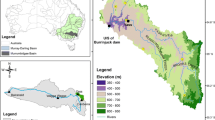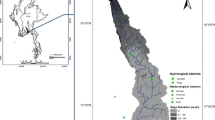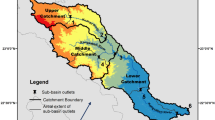Abstract
Catchments dominated by meltwater runoff are sensitive to climate change as changes in precipitation and temperature inevitably affect the characteristics of glaciermelt/snowmelt, hydrologic circle and water resources. This study simulated the impact of climate change on the runoff generation and streamflow of Chu River Basin (CRB), a glacierized basin in Central Asia using the enhanced Soil and Water Assessment Tool (SWAT). The model was calibrated and validated using the measured monthly streamflow data from three discharge gauge stations in CRB for the period 1961–1985 and was subsequently driven by downscaled future climate projections of five Global Circulation Models (GCMs) in Coupled Model Inter-comparison Project Phase 5 (CMIP5) under three radiative forcing scenarios (RCP2.6, RCP4.5 and RCP8.5). In this study, the period 1966–1995 was used as the baseline period, while 2016–2045 and 2066–2095 as the near-future and far-future period, respectively. As projected, the climate would become warmer and drier under all scenarios in the future, and the future climate would be characterized by larger seasonal and annual variations under higher RCP. A general decreasing trend was identified in the average annual runoff in glacier (−26.6% to −1.0%), snow (−21.4% to +1.1%) and streamflow (−27.7% to −6.6%) for most of the future scenario periods. The projected maximum streamflow in each of the two future scenarios occurred one month earlier than that in the baseline period because of the reduced streamflow in summer months. Results of this study are expected to arouse the serious concern about water resource availability in the headwater region of CRB under the continuously warming climate. Changes in simulated hydrologic outputs underscored the significance of lowering the uncertainties in temperature and precipitation projection.
Similar content being viewed by others
References
Aizen V B, Aizen E M, Melack J M, et al. 1997. Climatic and hydrologic changes in the Tien Shan, Central Asia. Journal of Climate, 10: 1393–1404.
Aizen V B, Kuzmichenok V A, Surazakov A B, et al. 2007. Glacier changes in the Tien Shan as determined from topographic and remotely sensed data. Global and Planetary Change, 56(3–4): 328–340.
Anandhi A, Frei A, Pierson D C, et al. 2011. Examination of change factor methodologies for climate change impact assessment. Water Resources Research, 47(3), W03501, doi: 10.1029/2010WR009104.
Anderson J R, Hardy E E, Roach J T, et al. 1976. A Land Use and Land Cover Classification System for Use with Remote Sensor Data. Washington: United States Government Printing Office.
Arnell N W, Livermore M J L, Kovats S, et al. 2004. Climate and socio-economic scenarios for global-scale climate change impacts assessments: characterising the SRES storylines. Global Environmental Change, 14(1): 3–20.
Chen F, Huang W, Jin L, et al. 2011. Spatiotemporal precipitation variations in the arid Central Asia in the context of global warming. Science China Earth Sciences, 54(12): 1812–1821.
Chen J, Ohmura A. 1990. Estimation of alpine glacier water resources and their change since the 1870s. In: Hydrology in Mountainous Regions: I. Hydrologic Measurements, the Water Cycle. Proceedings of the Two Lausanne Symposia. Wallingford: IAHS Press, 193: 127–135.
Cruz R V H, Harasawa M, LaI S, et al. 2007. Climate Change 2007: Impacts, Adaptation and Vulnerability. Contribution of Working Group II to the Fourth Assessment Report of the Intergovernmental Panel on Climate Change. Cambridge: Cambridge University Press, 469–506.
Cui Y H, Ye B S, Wang J, et al. 2010. Analysis of the spatial-temporal variations of the positive degree-day factors on the Glacier No.1 at the headwaters of the Urumqi River. Journal of Glaciology and Geocryology, 32(2): 265–274. (in Chinese)
Dufresne J L, Foujols M A, Denvil S, et al. 2013. Climate change projections using the IPSL-CM5 Earth System Model: from CMIP3 to CMIP5. Climate Dynamics, 40(9–10): 2123–2165.
Gassman P W, Reyes M R, Green C H, et al. 2007. The soil and water assessment tool: historical development, applications, and future research directions. Transactions of the ASABE, 50(4): 1211–1250.
Gassman P W, Sadeghi A M, Srinivasan R. 2014. Applications of the SWAT model special section: overview and insights. Journal of Environmental Quality, 43: 1–8.
Gent P R, Danabasoglu G, Donner L J, et al. 2011. The community climate system model version 4. Journal of Climate, 24(19): 4973–4991.
Giorgetta M A, Jungclaus J, Reick C H, et al. 2013. Climate and carbon cycle changes from 1850 to 2100 in MPI-ESM simulations for the Coupled Model Intercomparison Project phase 5. Journal of Advances in Modeling Earth Systems, 5(3): 572–597.
Hagg W, Braun L N, Weber M, et al. 2006. Runoff modelling in glacierized Central Asian catchments for present-day and future cliamte. Nordic Hydrology, 37(2): 93–105.
Hagg W, Braun L N, Kuhn M, et al. 2007. Modelling of hydrological response to climate change in glacierized Central Asian catchments. Journal of Hydrology, 332(1–2): 40–53.
Hu Z, Zhang C, Q S H, et al. 2014. Temperature changes in Central Asia from 1979 to 2011 based on multiple datasets. Journal of Climate, 27(3): 1143–1167.
Huang S, Krysanova V, Österle H, et al. 2010. Simulation of spatiotemporal dynamics of water fluxes in Germany under climate change. Hydrological Processes, 24(23): 3289–3306.
Immerzeel W W, van Beek L P H, Bierkens M F P. 2010. Climate change will affect the Asian water towers. Science, 328(5984): 1382–1385.
IPCC. 2007. Climate Change 2007: Synthesis Report. Contribution of Working Groups I, II and III to the Fourth Assessment Report of the Intergovernmental Panel on Climate Change. Geneva: IPCC.
Li B F, Chen Y N, Chen Z S, et al. 2013. Variations of temperature and precipitation of snowmelt period and its effect on runoff in the mountainous areas of Northwest China. Journal of Geographical Sciences, 23(1): 17–30.
Luo Y, Arnold J, Liu S, et al. 2013. Inclusion of glacier processes for distributed hydrological modeling at basin scale with application to a watershed in Tianshan Mountains, northwest China. Journal of Hydrology, 477: 72–85.
Lutz A F, Immerzeel W W, Gobiet A, et al. 2013. Comparison of climate change signals in CMIP3 and CMIP5 multi-model ensembles and implications for Central Asian glaciers. Hydrology and Earth System Sciences, 17(9): 3661–3677.
Malsy M, Aus der Beek T, Eisner S, et al. 2012. Climate change impacts on Central Asian water resources. Advances in Geosciences, 32: 77–83.
Mamatkanov D M, Bazhanova L V, Romanovskiy V V. 2006. Water Resources of Kyrgyzstan in the Recent Period. Ilim, Bishkek. (in Russian)
Meehl G A, Covey C, Delworth T, et al. 2007. The WCRP CMIP3 multi-model dataset: a new era in climate change research. Bulletin of the American Meteorological Society, 88(9): 1383–1394.
Mengistu D T, Sorteberg A. 2012. Sensitivity of SWAT simulated streamflow to climatic changes within the Eastern Nile River basin. Hydrology and Earth System Sciences, 16(2): 391–407.
Moriasi D N, Arnol J G, Van Liew M W, et al. 2007. Model evaluation guidelines for systematic quantification of accuracy in watershed simulations. Transactions of the ASABE, 50(3): 885–900.
Narama C, Kääb A, Duishonakunov M, et al. 2010. Spatial variability of recent glacier area changes in the Tien Shan Mountains, Central Asia, using Corona (∼1970), Landsat (∼2000), and ALOS (∼2007) satellite data. Global and Planetary Change, 71(1–2): 42–54.
Nash J E, Sutcliffe J V. 1970. River flow forecasting through conceptual model part I: a discussion of principles. Journal of Hydrology, 10(3): 282–290.
Neitsch S L, Arnold J G, Kiniry J R, et al. 2005. Soil and Water Assessment Tool Theoretical Documentation Version 2005. Grassland, Soil and Water Research Laboratory, Agriculture Research Services, Texas, USA.
Olsson O, Gassmann M, Wegerich K, et al. 2010. Identification of the effective water availability from streamflows in the Zerafshan river basin, Central Asia. Journal of Hydrology, 390(3–4): 190–197.
Rossi C G, Dybala T J, Moriasi D N, et al. 2008. Hydrologic calibration and validation of the Soil and Water Assessment Tool for the Leon River watershed. Journal of Soil and Water Conservation, 63(6): 533–541.
Saxton K E, Rawls W J. 2006. Soil water characteristic estimates by texture and organic matter for hydrologic solutions. Soil Science Society of America Journal, 70(5): 1569–1578.
Scoccimarro E, Gualdi S, Bellucci A, et al. 2011. Effects of tropical clones on ocean heat transport in a high-resolution coupled general circulation model. Journal of Climate, 24(16): 4368–4384.
Sherrield J, Goteti G, Wood E F. 2006. Development of a 50-year high-resolution global dataset of meteorological forcing for land surface modeling. Journal of Climate, 19(13): 3088–3111.
Siegfried T, Bernauer T, Guiennet R, et al. 2011. Will climate change exacerbate water stress in Central Asia? Climatic Change, 112(3–4): 881–899.
Sorg A, Bolch T, Stoffel M, et al. 2012. Climate change impacts on glaciers and runoff in Tien Shan (Central Asia). Nature Climate Change, 2(10): 725–731.
Tao H, Gemmer M, Bai Y, et al. 2011. Trends of streamflow in the Tarim River Basin during the past 50 years: human impact or climate change? Journal of Hydrology, 400(1–2): 1–9.
Unger-Shayesteh K, Vorogushyn S, Farinotti D, et al. 2013. What do we know about past changes in the water cycle of Central Asian headwaters? A review. Global and Planetary Change, 110: 4–25.
Vaghefi S A, Mousavi S J, Abbaspour K C, et al. 2014. Analyses of the impact of climate change on water resources components, drought and wheat yield in semiarid regions: Karkheh River Basin in Iran. Hydrological Processes, 28(4): 2018–2032.
Voldoire A, Sanchez-Gomez E, Salas y Mélia D, et al. 2011. The CNRM-CM5.1 global climate model: description and basic evaluation. Climate Dynamics, 40(9–10): 2091–2121.
Wu J, Luo Y, Li J, et al. 2014. Evaluation of CMIP5 modes’s simulation ability in the northwest arid areas of China. Arid Land Geography, 37(3): 499–508. (in Chinese)
Yatagai A, Kamiguchi K, Arakawa O, et al. 2012. APHRODITE: Constructing a long-term daily gridded precipitation dataset for Asia based on a dense network of rain gauges. Bulletin of the American Meteorological Society, 93(9): 1401–1415.
Zhang Y, Liu S Y, Ding Y J. et al. 2006. Observed degree-day factors and their spatial variation on glaciers in western China. International Glaciological Society, 43(1): 301–306.
Author information
Authors and Affiliations
Corresponding author
Rights and permissions
About this article
Cite this article
Ma, C., Sun, L., Liu, S. et al. Impact of climate change on the streamflow in the glacierized Chu River Basin, Central Asia. J. Arid Land 7, 501–513 (2015). https://doi.org/10.1007/s40333-015-0041-0
Received:
Revised:
Accepted:
Published:
Issue Date:
DOI: https://doi.org/10.1007/s40333-015-0041-0




